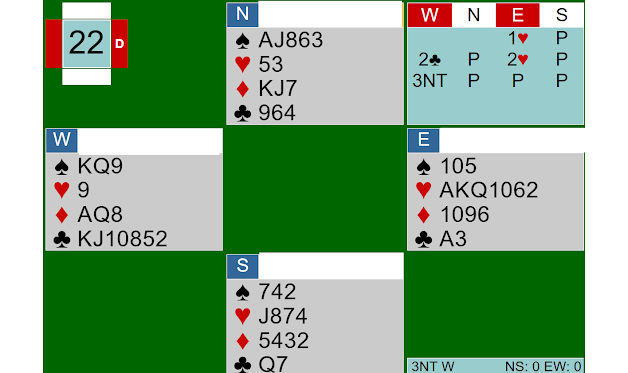Question: Was this a biddable slam?
Vic:
Yes, it was a biddable
slam.
South deserves to take 12
tricks in hearts, so it was also a makeable (small) slam.
Assuming the 2NT bid by North
(Responder) was Jacoby 2NT, Opener has a right to picture Responder with four
card heart support & 13+ HCPs. Opener has 16 HCPs, giving the partners a
total of at least 29 HCPs.
For small slams in NT,
33 HCPs is the common gold standard. By that standard (assuming Responder has
the minimum), this hand does not measure up to slam.
For small slams in a suit
contract, however, distribution features (singletons/voids) & the location
of six critical cards often enable slams with fewer than 33 HCPs (sometimes far
fewer). The six "critical cards" are the four Aces plus the King
& Queen of trump.
Playing Jacoby 2NT, a second
call of 3C by Opener promises a singleton or void in clubs. The correct second
call by Opener was 3S. For an experienced pair, I suspect a second call of 3S
would have initiated a cue bidding sequence that would have gotten the pair to
slam.
Looks to me like the 3C bid
by Opener was an attempt to show a two-suited hand. That is what Opener has,
but playing Jacoby 2NT, that is not what they have promised.
Over 3C, Responder then bid
3H which I would expect Opener to interpret as encouraging (the stronger the
hand, the slower the bidding). Opener proceeded to set the contract by bidding
4H. That was an unfortunate choice for more than one reason.
Opener knows they have a nine
card golden fit. Nine card fits are worth 2-3 HCPs more than eight card fits.
The spade singleton also makes opener's hand worth more than 16 HCPs. Finally,
Opener holds three of the six critical cards mentioned above. If Responder has
at least two of the other three, the partners definitely belong in slam.
Rather than end the auction
by bidding 4H, I would encourage Opener to bid 4NT (Blackwood). Responder
should subsequently show two Aces. Opener should then set the contract at 6H.
Ain't bridge a great game?






































